April 4, 2024
Innovation of the Month: Intersection Control Evaluation
Highway agencies use various Intersection Control Evaluation (ICE) processes and metrics to evaluate intersection geometry and control alternatives and to identify optimal geometric and control solutions for an intersection. These processes typically look at factors such as safety; operational, multimodal, and environmental considerations; right-of-way; cost impacts; and other considerations. ICE is a data-driven, performance-based framework and approach used to objectively screen intersection alternatives. Using ICE can help minimize risk of unexpected obstacles during construction while helping agencies select the best projects for implementation.
Recently, the National Academies of Sciences, Engineering, and Medicine posted Report 1087, "Guide for Intersection Control Evaluation (ICE)" through the National Cooperative Highway Research Program (NCHRP). This guide incorporates processes, objective performance metrics, and tools to help agencies provide consistent and objective ICE. In addition to the guide, the project produced nine implementation tools to facilitate States' use of the guide, including the ICE Process Tool and the Planning and Preliminary Engineering Applications Guide Tool for ICE.
A growing number of transportation agencies are developing and adopting ICE policies. Virginia, Ohio, and Colorado recently published ICE procedures and tools, bringing the number of States to adopt formalized ICE policies and procedures to 15. While there are differences among the States' policies and procedures, they are consistent in emphasizing transparency, flexibility, and adaptability. The NCHRP Guide makes it possible for agencies currently without an ICE policy or procedure to streamline development and adoption, while also using the ICE tools as starting points.
Agencies with ICE policies are realizing several benefits, including:
- Implementation of safer, more balanced, and more cost-effective solutions.
- Consistent documentation that improves the transparency of transportation decisions.
- Increased awareness of innovative intersection solutions and emphasis on objective performance metrics for consistent comparisons.
- The opportunity to consolidate and streamline existing intersection-related policies and procedures, including access or encroachment approvals, new traffic signal requests, and impact studies for development.
To learn more about ICE, visit the FHWA ICE website or contact Jeff Shaw, FHWA Office of Safety.
Ultra-Thin Bonded Wearing Course Protects Popular Massachusetts Route
Targeted pavement overlay solutions (TOPS) reduce maintenance, maximize previous investments, and lessen user delays by extending service life of pavement structures.
In 2018, the City of Newton, MA, searched for a solution to restore ride quality to a roadway section while sealing and protecting the underlying pavement. Ultra-thin bonded wearing course (UTBWC), an overlay composed of a heavy-tack application of polymer-modified emulsion, was selected for the roadway treatment. City officials considered UTBWC an environmentally and economically sustainable pavement solution. UTBWC is also known to effectively treat minor rutting and can help slow fatigue cracking.
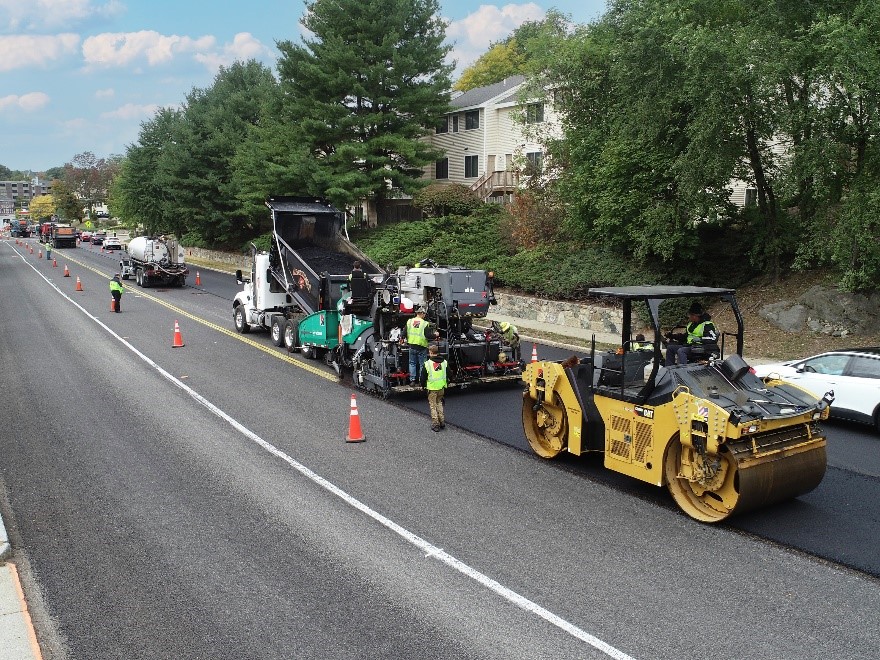
A crew places ultra-thin bonded wearing course as an overlay on a road in Newton, Massachusetts. (Source: All States Materials Group)
In 2020, the city completed a trial project to preserve a section of the deteriorating concrete roadway and in 2022, used UTBWC as an overlay over hot in-place recycling. One of the major benefits of UTBWC is how quickly traffic can resume on high-volume roadways. In some instances, the time to reopen was measured in minutes rather than hours.
To learn more about UTBWC or other TOPS applications, please contact TOPS co-team leads Tim Aschenbrener, FHWA Office of Preconstruction, Construction, and Pavements (asphalt) or Robert Conway, FHWA Resource Center (concrete).
National Work Zone Awareness Week (April 15-19, 2024)
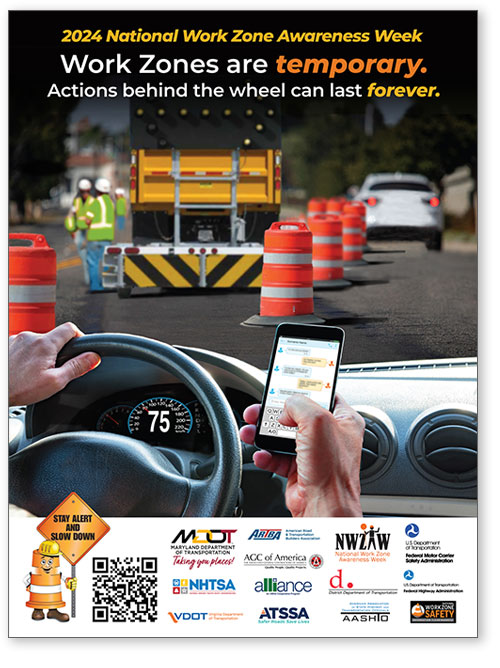
Work zones are critical for upgrading and maintaining our roadways, which not only provide critical access to the traveling public, but also support the Nation's economy through the transport of vital goods and services. Safety in work zones remains a significant issue: there were 891 work zone fatalities1 and 94 highway workers occupational fatalities in roadway construction sites2 in 2022. Additionally, 30 percent of fatal work zone crashes in 2022 involved large trucks or buses and many of these were rear-end collisions3. From 2021 to 2022, work zone fatalities decreased by 7.5 percent while fatal work zone crashes that involved speeding increased by 2 percent4. As a result, the Federal Highway Administration and its partners sponsor National Work Zone Awareness Week every spring to bring attention to motorist and worker safety and mobility issues in and around work zones.
Smart Work Zone technologies are one solution to help improve work zone safety. Most agencies specify the use of static warning signs indicating that trucks may enter the roadway from the work space. Unfortunately, because motorists often pass these signs repeatedly without encountering construction vehicles, they may eventually disregard the sign and fail to remain vigilant for a slow-moving vehicle potentially entering or exiting the work space. However, Smart Work Zone technologies can improve work space access point safety by dynamically warning approaching drivers about the presence of slow-moving construction vehicles entering or exiting work spaces among high-speed traffic, thereby improving work zone safety for all users. For more information, contact Martha.Kapitanov@dot.gov, Transportation Specialist, Work Zone Management Team.
New Innovator Now Available!
The March/April issue of Innovator is now available, accessible from your computer, tablet, or mobile phone to optimize your reading experience!
In this issue:
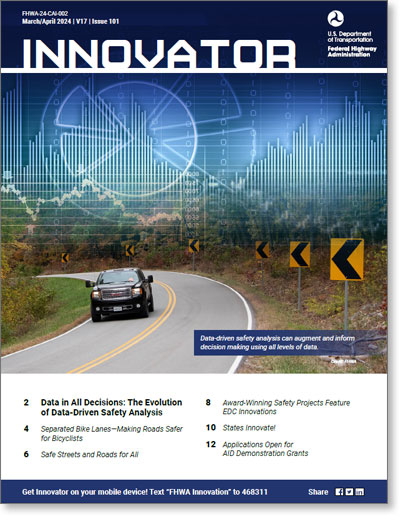
In this issue:
- Data in All Decisions: The Evolution of Data-Driven Safety Analysis
- Separated Bike Lanes—Making Roads Safer for Bicyclists
- Safe Streets and Roads for All
- Award-Winning Safety Projects Feature EDC Innovations
- Applications Open for AID Demonstration Grants
- And more...
Comments? Questions? We'd love your feedback! Drop us a line and let us know what you think.
Read past issues and sign up to receive Innovator by email here, or text "FHWA Innovation" to 468311 to get Innovator on your smartphone.
Applications Open for AID Demonstration Grants
Let's Innovate! The Accelerated Innovation Deployment (AID) Demonstration program provides incentive funds to eligible entities to accelerate the implementation and adoption of innovation in highway transportation. The 2024 AID Demonstration solicitation for FY2024 is open and the Federal Highway Administration (FHWA) plans to award up to $12.5 million in grants. Visit the AID Demonstration projects webpage to learn about the 127 grants and more than $95.7 million dollars that FHWA has awarded since the program's launch in 2014.
AID Demonstration funds are distributed through a competitive discretionary grant process. The required Notice of Intent must be submitted to Grants.gov on or before April 16, 2024, with an application deadline of May 28, 2024. Details on this funding opportunity are available on the AID Demonstration webpage and on Grants.gov (funding opportunity number 693JJ324NF-AIDDP).
Discover Home-Grown Innovations from Around the Country
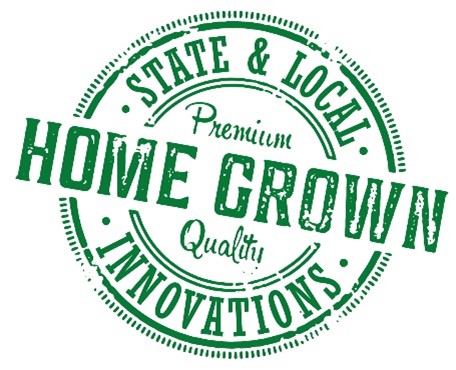
Are you interested in homegrown innovations being used by your peers in other parts of the country? The National STIC Network Showcase provides a summary of STIC Showcase entries from the EDC-7 Virtual Summit.
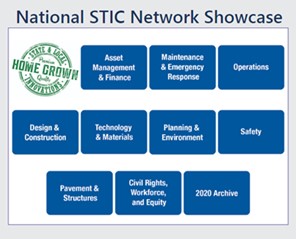
Learn about the Florida Department of Transportation's ZICLA Zipper bicycle buffering system, which uses a series of reflective, raised separators to protect cyclists and prevent motorists from entering the bike lane. This project is the first time Florida has used the system, though it has been widely used in Spain.
Celebrate the ingenuity of your peers and read about these innovations—developed and deployed in-house at transportation agencies nationwide.
Stay Up to Date on the EDC Innovations That Interest You Most

EDC teams are always on the move! If you blink, you could miss out on important webinars, case studies, tools, videos, and more. To never miss information for the EDC innovations that interest you most, visit the subscription page and select the topics you’d like to receive updates on directly from the teams that coordinate them.
Recent bulletins:
Equity in Safety Webinar Series 3/19/24
Sustainable Pavements 4/1/24
Local Aid Support 4/3/24
Strategic Workforce Development 4/3/24
Upcoming Events
Strategic Workforce Development Fireside Chat on Women in Construction
April 9, 2024, 1:00-2:30 ET Register
Lighting and the Environment Webinar
April 25, 2024, 1:00 - 3:00 pm ET Register
GHG: Goals, Objectives, Performance Measures, and Target Setting
April 30, 2024, 2:00-3:30 pm ET Register
Equitable Safety Data Analysis
May 22, 2024, 1:00-3:00 ET Register
Roadway Safety for People Experiencing Homelessness
July 24, 2024, 1:00-3:00 ET Register
About EDC
Every Day Counts, a State-based initiative of the Federal Highway Administration's Office of Innovation and Workforce Solutions, works with State, local, and privatesector partners to encourage the adoption of proven and underutilized technologies to deliver transportation projects more efficiently, enhance safety forall users, support a sustainable and resilient infrastructure, and incorporate equity inproject planning and delivery.
EDC News is a weekly publication highlighting successful EDC innovation deployments across the country.
EDC News is published weekly by the FHWA Center for Accelerating Innovation.
Disclaimer: The U.S. Government does not endorse products or manufacturers. Trademarks or manufacturers’ names appear in this document only because they are considered essential to the objective of the document. They are included for informational purposes only and are not intended to reflect a preference, approval, or endorsement of any one product or entity.
Except for the statutes and regulations cited, the contents of this document do not have the force and effect of law and are not meant to bind the States or the public in any way. This document is intended only to provide information regarding existing requirements under the law or agency policies.
Recommended Citation:
U.S Department of Transportation, Federal Highway Administration
EDC News; April 4, 2024
Washington, DC
https://doi.org/10.21949/1521777
1,3,4FARS 2021 Final File and 2022 Annual Report File, NHTSA. FARS data are from the 50 States, the District of Columbia, and Puerto Rico.
22021 and 2022 Census of Fatal Occupational Injuries, U.S. Department of Labor,Bureau of Labor Statistics, in cooperation with States, New York City, the District ofColumbia, and Federal agencies.


